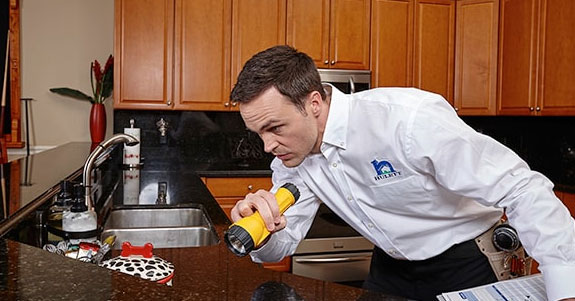On this website, some posts contain affiliate links, which means that if you buy a product using my link, I may earn a commission.
Prevent kitchen pests by cleaning up after meals, stocking pantry with canned or jarred food, using fridge for storage, sealing holes and cracks, taking out trash promptly, and regularly checking for pests. Keeping your kitchen pest-free involves wiping up crumbs and spills, storing food properly, and practicing excellent sanitation.
The most common kitchen pests are ants, cockroaches, silverfish, and carpet beetles. Avoid placing food back in the kitchen immediately after pest control treatment. Bug-proof your kitchen by eliminating their access to food and water sources. Common ways to control pests in the kitchen include maintaining cleanliness, sealing entry points, and removing potential hiding places.
Strategy 1: Regularly Clean Up Right After Meals
- Clean up right after meals: Wipe down countertops, tables, and floors to eliminate food debris and spills. Clean dishes and utensils promptly to prevent attracting pests.
- Stock your pantry with canned or jarred food items to minimize the risk of kitchen pests.
- Use your fridge and freezer more for storage, as sealed containers are less likely to attract pests.
- Seal any holes and cracks in your kitchen to prevent pests from entering.
- Take out the trash as soon as necessary to avoid attracting pests.
- Regularly check for the presence of pests to catch any signs of infestation early.
Preventing kitchen pests is essential for maintaining a hygienic and pest-free environment. By following these strategies, you can minimize the risk of pest infestation and ensure a clean and safe kitchen.
Strategy 2: Stock Your Pantry With Canned Or Jarred Food Items
- Regularly Clean Up Right After Meals
- Stock Your Pantry with Canned or Jarred Food Items
- Use Your Fridge and Freezer More for Storage
- Seal Holes and Cracks
- Take Out the Trash as Soon as Necessary
- Regularly Check for the Presence of Pests
Pour a small amount of apple cider vinegar into a bowl or glass, cover it with plastic wrap (use a rubber band to keep it tight) and poke holes…
No, it is not safe to place food back in the kitchen soon after the pest control treatment. Ideally, it is advised not to put food back immediately.
Prevention As a First Line of Defense Against Pests: Immediately wipe up any crumbs or spills from countertops, tables, floors, and shelves. Store food in…
Try to Find their Food and Water Source: Another priority is to remove the food and water source that they might be attracted to. Make sure…
To easily keep pests out, clean up food scraps, throw out exposed food containers, and empty trash bins regularly. More specifically, it is best…
Ways to ensure that pests do not find a place to hide in your kitchen: Keep kitchen equipment that is hard to move on rollers to make it easier…
The key to keeping pests out of the kitchen is to eliminate their access to food and water sources, which they need to survive. This can be done by practicing excellent sanitation in the kitchen: Make sure to wipe up all crumbs and spills on the floor, kitchen counters, cabinets, and refrigerator in a timely manner.
Common Kitchen Insects: A number of insects feed on spilled food and debris that work their way into cracks, crevices, behind kitchen appliances, or under sinks and cabinets. The most common pests are ants, cockroaches, silverfish, and carpet beetles.
Home remedies for small insects in the kitchen
Best way to prevent pest infestation in a restaurant
How to get rid of tiny bugs on the kitchen counter
Strategy 3: Use Your Fridge And Freezer More For Storage
| Strategy 3: Use Your Fridge and Freezer More for Storage |
| Store perishable food items in the refrigerator or freezer to discourage pests. Properly seal containers and bags to prevent odors from attracting pests. |
One effective strategy to prevent pests in the kitchen is to utilize your fridge and freezer for storage. By storing perishable food items in these appliances, you can discourage pests from accessing them. It’s important to properly seal containers and bags to prevent the release of odors that can attract pests. This will help keep your food fresh and reduce the risk of an infestation. Regularly check the refrigerator and freezer for any signs of pests and ensure they are in good working condition. By following these steps, you can create a less appealing environment for pests in your kitchen and protect your food from contamination.
Strategy 4: Seal Holes And Cracks
To prevent kitchen pests, it’s important to seal any holes and cracks in your kitchen. By doing so, you can effectively block their entry points and reduce the risk of infestation. Regularly inspect your kitchen for any openings and seal them with caulk or other suitable materials.
| Regularly Clean Up Right After Meals. |
| Stock Your Pantry with Canned or Jarred Food Items. |
| Use Your Fridge and Freezer More for Storage. |
| Seal Holes and Cracks. |
| Take Out the Trash as Soon as Necessary. |
| Regularly Check for the Presence of Pests. |
Strategy 5: Take Out The Trash As Soon As Necessary
Avoid letting trash sit in the kitchen for extended periods. Dispose of kitchen waste promptly and properly to prevent pests from being attracted.
| Prevention Tips: |
|---|
| Regularly Clean Up Right After Meals. |
| Stock Your Pantry with Canned or Jarred Food Items. |
| Use Your Fridge and Freezer More for Storage. |
| Seal Holes and Cracks. |
| Take Out the Trash as Soon as Necessary. |
| Regularly Check for the Presence of Pests. |
To easily keep pests out, clean up food scraps, throw out exposed food containers, and empty trash bins regularly. Additionally, make sure to wipe up all crumbs and spills on the floor, kitchen counters, cabinets, and refrigerator in a timely manner. By practicing excellent sanitation in the kitchen, you can eliminate their access to food and water sources, which pests need to survive.
In conclusion, by following these prevention tips and practicing good hygiene in the kitchen, you can effectively control pests and create a pest-free environment.
Strategy 6: Regularly Check For The Presence Of Pests
|
When it comes to pest control in the kitchen, it’s important to have a strategy in place. Strategy 6: Regularly Check for the Presence of Pests. Conduct routine inspections to identify and address any signs of pests. Use pest control methods such as traps or sprays as needed. Preventive Measures:
How To Get Rid Of Pests:
The key to keeping pests out of the kitchen is to eliminate their access to food and water sources, which they need to survive. This can be done by practicing excellent sanitation in the kitchen: Make sure to wipe up all crumbs and spills on the floor, kitchen counters, cabinets, and refrigerator in a timely manner. Common kitchen pests include ants, cockroaches, silverfish, and carpet beetles. Conduct regular inspections to identify any signs of infestation and take immediate action to address the issue. By following these preventive measures and maintaining good hygiene practices, you can effectively control pests in your kitchen. |


Credit: www.bugs.com
Frequently Asked Questions On Pest Control In Kitchen
What Is The Best Way To Control Pest In The Kitchen?
To control pests in the kitchen, follow these steps: 1. Clean up immediately after meals. 2. Stock pantry with canned or jarred food. 3. Use fridge and freezer for storage. 4. Seal holes and cracks. 5. Take out trash promptly. 6.
Regularly check for pests. Remember, sanitation is key to keeping pests away!
How Can I Get Rid Of Bugs In My Kitchen?
To get rid of bugs in your kitchen, follow these steps: 1. Clean up immediately after meals. 2. Store food in sealed containers. 3. Use the fridge and freezer for storage. 4. Seal any holes and cracks. 5. Take out the trash regularly.
6. Check for pest presence regularly. Remember, prevention is key to keeping your kitchen bug-free.
What Are Two Most Common Pest In The Kitchen?
The two most common pests in the kitchen are ants and cockroaches. These insects feed on spilled food and can be found in cracks, crevices, and behind appliances or under sinks and cabinets. It is important to practice excellent sanitation to prevent their infestation.
How Do I Bug Proof My Kitchen?
To bug-proof your kitchen, follow these steps: 1. Clean up immediately after meals. 2. Stock pantry with sealed food items. 3. Use fridge and freezer for storage. 4. Seal holes and cracks. 5. Take out trash promptly. 6. Regularly check for pests.
Conclusion
In order to maintain a clean and pest-free kitchen, it is essential to follow some preventive measures. Regularly cleaning up after meals, stocking your pantry with tightly sealed food items, and using the fridge and freezer for storage are effective ways to deter pests.
Additionally, sealing any holes and cracks, taking out the trash promptly, and regularly checking for the presence of pests can help in preventing infestations. By implementing these simple steps, you can create a safe and hygienic environment in your kitchen.
Remember, prevention is key to keeping pests away and maintaining a healthy living space.
On this website, some posts contain affiliate links, which means that if you buy a product using my link, I may earn a commission.

